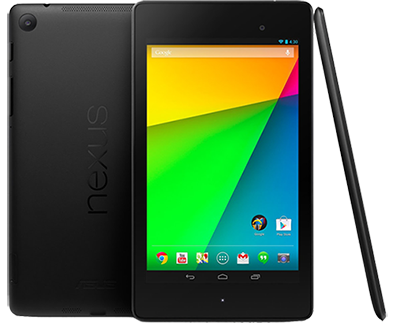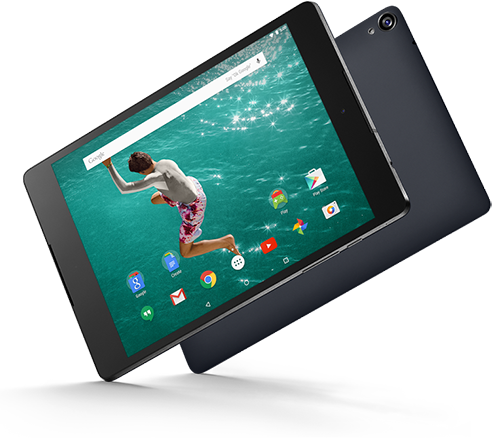Best Tablets: Holiday 2014
by Brandon Chester on November 28, 2014 8:00 AM ESTAndroid Tablets
The Android tablet space is more diverse than the selection of tablets running iOS due to the sheer number of manufacturers that make Android tablets. However, it seems like many of them in the low range make compromises that severely reduce their appeal, and other high end tablets like the Galaxy Tab S are let down by SoCs that struggle against A7, A8, Snapdragon 805, and Tegra K1. That being said, we've seen the launch of two new tablets this year from manufacturers that one might be surprised to see in the tablet market. There's also an old favorite that remains almost as compelling now as it did when it launched quite some time ago.
Our recommendation at the most affordable price point is the Nexus 7 (2013). The recommendation of a budget tablet from over one year ago may sound strange, but the Nexus 7 remains a very high quality and capable device for its price of $229. This returns to the point about other inexpensive Android tablets not being very compelling due to sacrifices in areas like the display or the build quality. It may be that other manufacturers have found it difficult to compete with Google who doesn't necessarily need to make profit off of the device itself if they believe they will get revenue from advertising and purchases on Google Play.
Whatever the case may be, the Nexus 7 still seems to be the best Android tablet available at this price point. Its 1920x1200 display is still best in class for 7" tablets, with accurate factory calibration and a maximum brightness that stands high above every other tablet. The build quality and battery life are also exceptional for its price, and although the APQ8064-1AA SoC has aged since it released, it's still a capable device that receives updates directly from Google. The biggest issue about the Nexus 7 is finding it, as Google has recently discontinued it and removed it from sale on Google Play. That being said, if you can find it at another online retailer or a nearby store, it's definitely worth considering.
Our next recommendation is the NVIDIA SHIELD Tablet which starts at $299 with an optional $59 controller. This recommendation is aimed at anyone who wants to use the Android OS and wants to be able to play games on their tablet. Although some may laugh at the idea of a tablet as a gaming device, when paired with its controller the SHIELD Tablet is actually a viable gaming device. NVIDIA has put a lot of effort into taking classic games like Half Life 2 and Portal that were once limited to gaming consoles and PCs and making them available on the SHIELD Tablet. Their new GRID game streaming service has also just begun its expansion, which will allow people to play various games streamed over a network connection.
For users who don't intend to play many games, the SHIELD Tablet is still worth considering. The Cortex-A15 based Tegra K1 is very competitive with the CPU performance of other Android tablets, and the GPU performance is rivaled only by Apple's A8X in the iPad Air 2. The battery life is also good at 10.83 hours, although it doesn't really stand out from other tablets. The display may also be an issue for some buyers, with similar panel characteristics as the iPad Mini. This puts it significantly behind the cheaper Nexus 7 for both display accuracy and brightness.
From a software support perspective, one might expect the SHIELD Tablet to be a worse option than the Nexus 7. However, NVIDIA has proven to be very quick in shipping updates, and the SHIELD Tablet has already been updated to the recently released Android Lollipop; that should put to rest any concerns about updates. Ultimately, for gamers who want Android, the SHIELD Tablet is the best choice. For those less interested in gaming, one will have to consider the $70 increase in price over the Nexus 7, and decide whether to prioritize performance or display quality.
Last, but not least, we have the newly released Nexus 9 that is made by HTC and starts at $399. This is the first Nexus device that Google has had HTC build since the Nexus One, and it's HTC's first tablet since they exited the market in 2012. In a way, the Nexus 9 can be called a successor to the Nexus 7, as its release coincided with the Nexus 7 being discontinued. That being said, the Nexus 9 is definitely not the budget tablet that the Nexus 7 was. At $399, it's well within the price territory of the iPad, and it's almost double the cost of the Nexus 7. Although there are other high end Android tablets at this price point, the Nexus 9 feels like the only Android tablet that actually justifies a premium price by competing with the silicon inside of Apple's iPad.
Inside the Nexus 9 is NVIDIA's Tegra K1 Denver, making it one of the first 64-bit Android devices. The display maintains the standards that Google set with the Nexus 7, with accurate color calibration and a high brightness, although its larger size prevents it from reaching the brightness of the Nexus 7. The tablet is primarily plastic, with a metal band around the edge. At $399 users may be hoping for a bit more in terms of materials, and reports of significant flex in the back cover don't help with giving it a premium feel.
Despite some concerns about the build, at $399 the Nexus 9 is really the obvious choice for anyone looking for a high end tablet running Android. We haven't seen any other Android tablets launch this year that compete with both its display and its speed. However, it may be a hard sell for anyone without any platform loyalty who is choosing between iOS and Android. The build quality and materials just aren't up to the standard of the iPad, and the 4:3 aspect ratio can cause scaled up applications to look worse than normal.
In the end this will again be up to the preference of the user. The iPad Air has more premium materials and a better feel, and perhaps a better selection of tablet software. However, it falls behind in its CPU and GPU performance, and the 1GB of RAM on a 64-bit iOS can be problematic. Despite some disappointments with the build, the Nexus 9 is still a very capable tablet, and it's the only Android tablet that manages to give high end hardware across the board.













87 Comments
View All Comments
gailthesnail - Sunday, November 30, 2014 - link
I have a vivotab note 8 that I've been looking to get rid of actually.TT master - Friday, November 28, 2014 - link
I am a really big fan of Anand Tech but I really wonder if these articles are required on Anand Tech because obviously Anand Tech is not for the average Joe or so I believe. Most guys over here are really tech savvy to know which tablet or laptop fits them the best and at which price. Plus I really thought people over here claiming that AT was biased to Apple was false but after comparing the reviews of Iphone 6 and One Plus One. I really think you guys give a lot more attention to Apple and just do away with smartphones from Chinese companies. Tom's hardware review of One Plus One was actually much more detailed and I kind of found it better.http://www.tomshardware.com/reviews/oneplus-one-sm...
stlc8tr - Friday, November 28, 2014 - link
The Samsung Tab Pro 8.4 for $200 is easily the best deal available today for Android tablets, IMO.2560x1600 8.4" screen with a microSD card slot.
Brandon Chester - Friday, November 28, 2014 - link
The SoC isn't there, and that coupled with the high res display is just not a good experience.stlc8tr - Saturday, November 29, 2014 - link
Perhaps not for gaming but for comic reading and text-based apps, the high res display is fantastic. Also, with a uSD slot, you can easily take along 64GB of videos.I purchased mine earlier this year for a lot more and use it every day instead of the Nexus 7. Of course, YMMV if you are into gaming.
PC Perv - Sunday, November 30, 2014 - link
Hello? It runs on S800. The Nexus 7 runs on S400. Tap Pro is cheaper than the Nexus 7.You'd have to be an idiot to pick the Nexus 7 for $230 over the Tab Pro 8.4 for $200.
PC Perv - Sunday, November 30, 2014 - link
Correction: Nexus 7 runs on S4 Pro (Quad Krait 200)Brandon Chester - Sunday, November 30, 2014 - link
Adreno 330 and S800's memory bandwidth is completely and utterly insufficient to drive WQXGA at high frame rates. Also, the "S4 Pro" APQ8064–1AA in the Nexus 7 is a Krait 300 part.Brandon Chester - Sunday, November 30, 2014 - link
Also it's an RGBW panel, and it's normally $300 so I still don't see the appeal at all.PC Perv - Sunday, November 30, 2014 - link
Ignorant hogwash. The Tab Pro 8.4 uses RGB stripes. Not that there is anything wrong with RGBW used on Tab Pro 10.1. But your mind is made up anyway. Do not let the facts get in your way.